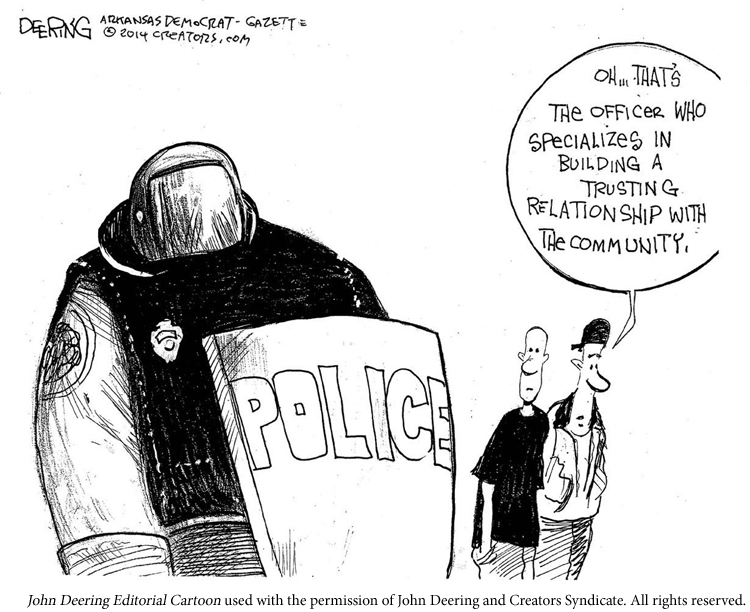John Deering Cartoon
John Deering Cartoon

John Deering serves as chief editorial cartoonist at the Arkansas Democrat-Gazette, a post he has held for over fifteen years. His cartoons are syndicated in publications across the country. Like the other cartoonists featured in this section, he has won numerous awards. Like the previous cartoon, this one is a response to the events in Ferguson, Missouri, during 2014. Do you think the message of the cartoon would have been different had the two young gentlemen on the right side of the cartoon been portrayed as members of ethnic minority groups and especially as African American? Why or why not?
RESPOND •
How would you state the argument each cartoon is making? In particular, what position or stance is the cartoonist taking with respect to the topic of the cartoon? What evidence can you cite for your claim?
Cartoonists who create single-panel cartoons like these face great challenges: they have limited resources and space to make their argument clear, and they must do so in a humorous way. A key way they succeed is by paying careful attention to visual and verbal detail. Choose two of these cartoons you think are especially effective in this regard, and be prepared to explain to your classmates how the cartoonists have used visual images and words effectively in ways that support each cartoon’s argument.
A common source of humor is the juxtaposition of things that normally do not occur together. Where do we see evidence of this strategy in each of these cartoons?
How does each cartoonist rely on stereotypes to make his point? In other words, which stereotypes common in American society do we see represented in these cartoons, and how does each cartoonist represent them so that they are immediately identifiable by readers?
How do the last two cartoons respond to the events in Ferguson during 2014? Do you consider either an especially appropriate response to those events? Collect several cartoons about these events or a similar event that has divided the country along various lines of social difference, and write a rhetorical analysis of them. (See Chapter 6 on writing rhetorical analyses.) We’d encourage you to collect cartoons from different kinds of sources. Both of these cartoons are from major newspapers in the South. Do cartoons in other regions treat the issue differently? And what about cartoons in newspapers produced for the African American community?
As noted in the introduction to this selection, understanding humor requires a great deal of local contextual information. Imagine that a newly arrived international student asked you to explain one of these cartoons to her/him. In several healthy paragraphs, write a description and an explanation of the cartoon you find most interesting. Begin by describing what readers see when they read the cartoon; then move on to explain what the cartoon means. Be sure to deal with the issues raised in questions 1–4. Conclude by explaining what Americans would likely find humorous about the cartoon and what the cartoon tells us about American society.